Xerocomus Quél.
Recent molecular studies have shown that Xerocomus in its current circumscription is likely an artificial grouping and it is possible that it will be split at some point into smaller genera. Molecular studies also have changed our understanding about the species of xerocomoid boletes showing that morphological features are quite variable in this group. Not only microscopic study is essential for determination, but scanning electron microscope will be often needed in this “genus” as the spore ornamentation is not always seen under ordinary light microscope. Do bear in mind that macroscopic characters, such as colours, cracking cuticle, etc., tend to intergrade between the different species. Note that Boletus impolitus and Boletus depilatus that were shown to be close to Xerocomus subtomentosus and its allies, are here retained in Boletus for practical reasons. The same applies also for Phylloporus pelletieri, placed here in a genus of its own, but being also close to Xerocomus subtomentosus group.
Although large reference list will be found under most of the species, one should always consult Ladurner & Simonini (2003) having in mind that there are some new species (X. chrysonemus, X. marekii, X. silwoodensis) described after this otherwise superior book was printed. Useful keys, covering most of the European xerocomoid boletes (except some southern taxa) are provided by Knudsen & Vesterholt (2008), Hills (2008) and Kibby (2011), the later also featuring an excellent comparison chart.
Fruitbody medium to small sized, boletoid, without veil and ring. Some southern species have secondarily angiocarpic development and then a ring of coarse granules is observed on the stipe, where the cap margin was initially attached. Stipe solid, often tapering towards the base. Flesh variously coloured, changing or not when exposed to air. Tubes not separable from each other, instead tearing apart. Pores usually angular.
Xerocomus ichnusanus Alession, Galli & Littini
Description
Fruitbodies single or often clustered in groups. Cap up to 7 cm, at first hemispherical, then convex, finally flat-convex, flat or slightly depressed, glabrous or somewhat fibrillose, sometimes finely cracked, clay buff or fawn, later purplish date or date brown, sometimes spotted purplish chestnut, bay or cigar brown; surface unchanging when bruised. Stipe tapering or spindle-shaped, somewhat rooting, in the upper portion straw to buff coloured, downwards rusty, pale fulvous, snuff brown or cigar brown, sometimes almost black at the same base, slightly blueing after rough handling; stipe surface with a distinct reticulum and usually with a ring-like pattern of coarse granules in the upper portion, downwards finely granulate. Flesh pale lemon yellow in the stipe, whitish in the cap, vinaceous to vinaceous-brown in the stipe base, blueing when exposed to the air. Tubes lemon yellow when young, then with somewhat olivaceous tint, blueing when injured. Pores angular, lemon yellow when young, later with olivaceous tint and often rusty spotted with age, blueing when bruised. Smell not distinctive. Taste distinctly acid. Spores 10–14.5 × 4.5–7 μm. Pileipellis (the cap cuticle) a trichoderm of interwoven branched septate thin-walled hyphae, terminal cells mostly cylindrical with rounded apex, 25–75 × 7.5–10 μm, ratio 3–10.
Habitat. In warm broadleaf woodlands, mycorrhizal with oaks (Quercus).
Distribution. Not yet fully understood, but as far as currently known, Xerocomus ichnusanus is a southern species. Records are known from Bulgaria, France, Greece, Italy and Spain.
Photographs
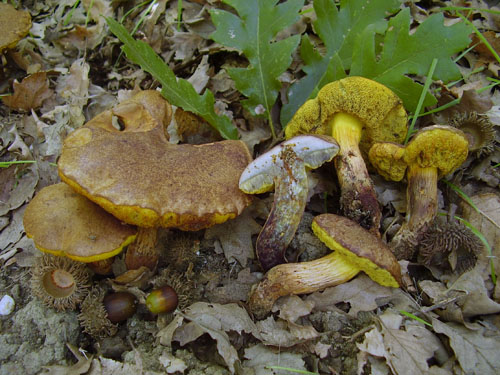
Typical fruitbodies of Xerocomus ichnusanus. (photo M. Gelardi)
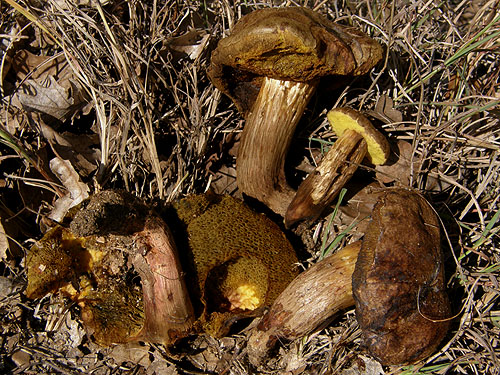
Old fruitbodies of Xerocomus ichnusanus. (photo B. Assyov)
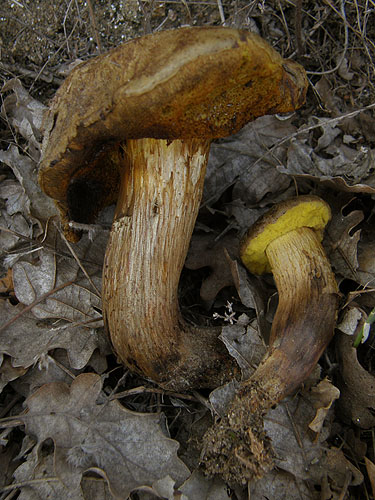
Fruitbodies of Xerocomus ichnusanus. (photo B. Assyov)
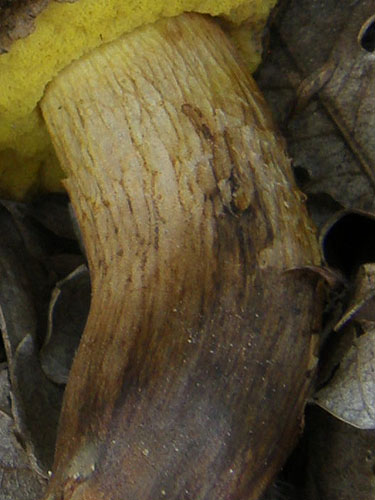
Detail of the stipe surface of Xerocomus ichnusanus. Note the network-like pattern. (photo B. Assyov)
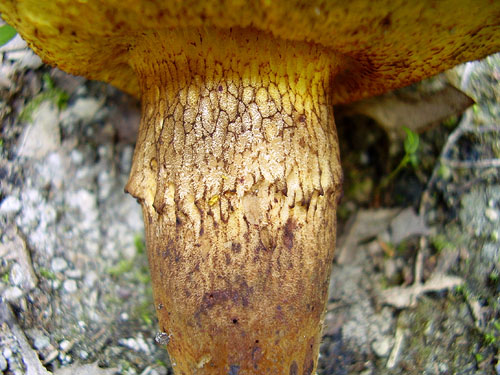
Detail of the stipe surface of Xerocomus ichnusanus. The network and the ring-like structure of coarse granules is seen in this case (photo M. Gelardi)
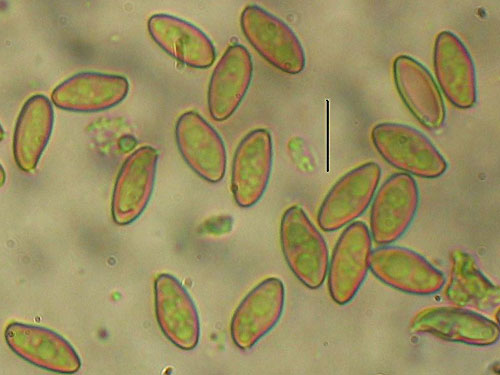
Spores of Xerocomus ichnusanus. Scale bar = 10 μm. (photo B. Assyov)
Important literature
Alessio, C.L. 1984. Un Boleto non ancora noto: Boletus ichnusanus Alessio, Galli & Littini. – Bolletino del Gruppo Micologico Bresadola 27: 166–170.
Alessio, C.L. 1985. Boletus Dill. ex L. (sensu lato). – In: Fungi Europaei. Vol. 2. Pp. 1–705. Libreria editrice Biella Giovanna, Saronno.
Assyov, B. & Stoykov, D.Y. 2011. First record of Boletus ichnusanus (Boletaceae) in Bulgaria. – Phytologia Balcanica 17: 269–272. (available online on site)
Chevtzoff, B. 1998. Xerocomus ichnusanus Alessio, Galli R & Littini, Boletales nouvelle pour la France. – Bulletin Semestriel de la Fédération des Associations Mycologique Méditérraneennes 13 : 14–20. (available online on site)
Engel, H., Dermek, A., Klofac, W., Ludwig, E. & Brückner, T. 1996. Schmier – und Filzröhrlinge s. l. in Europa. Die Gattungen Boletellus, Boletinus, Phylloporus, Suillus, Xerocomus. Verlag Heinz Engel, Weidhausen b. Coburg.
Estadès, A. & Lannoy, G. 2004. Les bolets européens. – Bulletin Mycologique et Botanique Dauphiné-Savoie 44(3): 3–79.
Galli, R. 1998. I Boleti. Atlante pratico-monographico per la determinazione dei boleti. Edinatura, Milano.
Gelardi, M. 2007. Interessanti Boletaceae mediterranee rinvenute nel Lazio: Xerocomus ichnusanus e X. persicolor. – Bolletino del Gruppo Micologico G. Bresadola – Nuova Serie 50(1–3): 141–160.
Ladurner, H. & Simonini, G. 2003. Xerocomus s.l. – In: Fungi Europaei. Vol. 8. Pp. 1–527. Edizioni Candusso, Alassio.
Lannoy, G. & Estadès, A. 2001. Les Bolets. Flore mycologique d’Europe. Documents Mycologiques Mémoire Hors série no. 6. Pp. 1–163. Association d’Écologie et de Mycologie, Lille.
Κωνσταντινίδης, Γ. 2009. Μανιτάρια, φωτογραφικός οδηγός μανιταροσυλλέκτη. Αυτοέκδοση, Αθήνα. [Konstantinidis, G. 2009. Mushrooms, a photographic guide for collectors. Published by the author, Athens.]
Polemis, E., Dimou, D.M., Tzanoudakis, D. & Zervakis, G.I. 2012. Annotated checklist of Basidiomycota (subclass Agaricomycetidae) from the islands of Naxos and Amorgos (Cyclades, Greece). – Annales Botanici Fennici 49: 145–161. (available online)